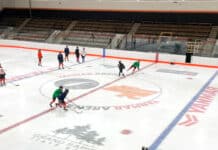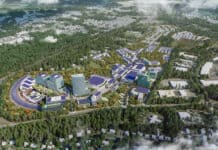By Doug Lodder
Another March Madness is in full swing and with all the thrills that go with it — buzzer beaters, bracket busters, and Cinderella stories. This year’s NCAA tournament welcomed Salt Lake City’s Vivint Smart Home Arena — home to the NBA Utah Jazz — as a host site for the first and second rounds of the men’s championship on March 16 and 18, 2017. For two action-packed days, six games were played at the arena, bringing in floods of college basketball fans ready to stream and share their March Madness experiences over Facebook, Snapchat, Instagram stories, and more.

To handle fans’ voracious appetites for mobile data during March Madness and anytime, Vivint Smart Home Arena turned to its new cellular Distributed Antenna System (DAS) network to ensure seamless connectivity. DAS solutions are proving their worth across sports and entertainment facilities, as well as other large venues with significant population density like class A and B office buildings, convention centers, airports, and malls. The technology solves a building’s mobile capacity and coverage issues by deploying hundreds of small antennae throughout a facility and integrating them into a cohesive cellular network. These individual antennae can be turned up or down, easily adjusting to provide additional cellular capacity to fans when it’s needed most, such as tip-off or halftime.
 Whether it’s a Jazz game or NCAA basketball tournament, DAS has been a slam dunk at Vivint Smart Home Arena. The arena completed the install of two DAS networks in 2016 as part of the kickoff to a massive $125 million renovation project at the facility that will also include redesigned lower and upper bowl concourses; new social spots; upgraded private clubs/suites; and a new indoor lobby. Vivint has two separate DAS integrations. One DAS is dedicated to boosting cellular coverage for fans connected experiences. The second is a commercial public safety DAS that is part of the arena’s emergency-preparedness strategy. This network allows first responders to effectively communicate with one another during an incident.
Whether it’s a Jazz game or NCAA basketball tournament, DAS has been a slam dunk at Vivint Smart Home Arena. The arena completed the install of two DAS networks in 2016 as part of the kickoff to a massive $125 million renovation project at the facility that will also include redesigned lower and upper bowl concourses; new social spots; upgraded private clubs/suites; and a new indoor lobby. Vivint has two separate DAS integrations. One DAS is dedicated to boosting cellular coverage for fans connected experiences. The second is a commercial public safety DAS that is part of the arena’s emergency-preparedness strategy. This network allows first responders to effectively communicate with one another during an incident.
Satisfying Mobile Demands: Step-by-Step
While March Madness will come and go, the demand for connectivity will not. Mobile data consumption continues to skyrocket, which will directly impact facility management operations. According to Cisco’s latest forecast, global mobile data will increase sevenfold by 2021 at a compound annual growth rate of 47%. This level of activity and demand signals the tremendous need for smart wireless infrastructures.
Venues must plan for mobile data growth or could be left behind. Here’s a quick step-by-step guide facility executives should follow to satisfy the mobile demands of today — and the years ahead.
Step 1: Plan. Going into the planning process, understand what’s in the wireless toolbox and opt for technologies that can future-proof your venue and move with data growth. Different technologies can solve different challenges. To boost cellular signals, small cells or DAS may be the best option, while turning to Wi-Fi to round out the connected experience.
When analyzing wireless coverage, be sure to identify cellular performance by carrier (e.g. AT&T, Sprint, T-Mobile, Verizon). Look to neutral host network operators who can conduct a site walk and run radio frequency (RF) testing to determine what carrier-grade equipment is required to boost signals. This partner should have relationships with all Tier 1 carriers as this can help boost revenue opportunities through their leasing participation on the wireless network.
Remember to think of wireless infrastructure as a utility that is worth the investment and necessary to ensuring healthy foot traffic within a building. The profitability of a property can skew based on its ability to deliver mobile connectivity.
Step 2: Design and Build. The right wireless solution can benefit new construction, aging historic buildings, modern architectural structures and more without distracting from the building’s appeal. Elect to use modern wireless technology during the design phase so that the equipment is discreet and does not interfere with aesthetics.
Before the buildout begins, also work with a wireless partner to create a network design that overcomes structural obstacles, such as large cement columns, to transport mobile signals at full strength. Leading wireless providers have decades of technical and operational expertise to strategically design and place antennae where the equipment is best suited.
Step 3: Manage. The management of a new wireless network involves many different touchpoints and operational teams have found it most effective when outsourcing the work. Wireless experts help ensure the same consistent network is deployed across the facility, while allowing in-house IT and facility staff to focus on other business matters.
The right network operator should provide end-to-end management 24/7/365. These services span on-call resources to maintain consistent network service level availability (SLA) standards; regular maintenance; on-site support; and delivery of recurring reports to showcase network data and analytics.
Building a winning wireless network is no easy feat, but by following these steps, facility management experts will be on their way to being a champion in connectivity.
 Lodder is senior vice president of business development for Boingo’s DAS, offload and wholesale businesses. Lodder oversees the strategy and development of Wi-Fi, DAS and small cell networks for Boingo’s new and existing venue partnerships as well as the monetization of those networks through partnerships with wireless carriers (DAS, offload) and wholesale partners (American Express, Mastercard). Boingo is the exclusive DAS provider at Vivint Smart Home Arena.
Lodder is senior vice president of business development for Boingo’s DAS, offload and wholesale businesses. Lodder oversees the strategy and development of Wi-Fi, DAS and small cell networks for Boingo’s new and existing venue partnerships as well as the monetization of those networks through partnerships with wireless carriers (DAS, offload) and wholesale partners (American Express, Mastercard). Boingo is the exclusive DAS provider at Vivint Smart Home Arena.




















![[VIDEO] Collect Asset Data at the Speed of Walking a Building](https://facilityexecutive.com/wp-content/uploads/2024/02/maxresdefault-324x160.jpg)